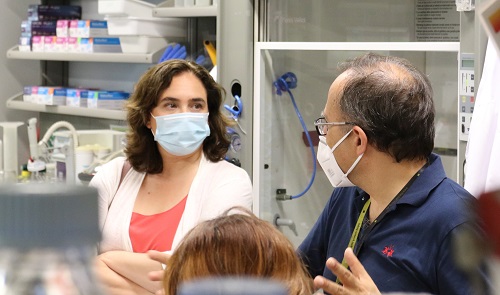Postdoctoral researcher at the Protein Phase Transitions in Health and Disease Research group
Ref: Postdoctoral / Deadline: 24th August
Group leader
Ref: Postdoctoral / Deadline: 24th August
Ref: Lab Technician / Deadline: 29th July 2022
 Benedetta Bolognesi, group leader at IBEC has been collaborating with “Maldita Ciencia” to clarify doubts and rumours about Covid-19″.
Benedetta Bolognesi, group leader at IBEC has been collaborating with “Maldita Ciencia” to clarify doubts and rumours about Covid-19″. The Mayor of Barcelona, Ada Colau, visited IBEC facilities last Friday to learn, by our Director and a group of researchers, how bioengineering can help find solutions to health problems such as COVID19, cancer, or degenerative diseases.
The Mayor of Barcelona, Ada Colau, visited IBEC facilities last Friday to learn, by our Director and a group of researchers, how bioengineering can help find solutions to health problems such as COVID19, cancer, or degenerative diseases.When in early 2020, more than 200 scientists gathered in La Pedrera in Barcelona to discuss the present and future of bioengineering, no one imagined that the world would experience the first pandemic of the 21st century and that science would take on more importance than ever.
Results showed that aggregation of TDP-43 is not harmful but actually protects cells, changing our understanding of ALS and opening the door to radically new therapeutic approaches.
Amyotrophic lateral sclerosis (ALS) is a devastating and incurable nervous system disease that affects nerve cells in the brain and spinal cord, causing loss of muscle control and normally death within a few years of diagnosis. In ALS, like in other neurodegenerative diseases, specific protein aggregates have long been recognized as the pathological hallmarks, but it is not clear whether they represent the actual cause of the disease. Indeed, alleviating aggregation has repeatedly failed as a therapeutic strategy when trying to treat neurodegenerative diseases such as Alzheimer’s disease.
 The start of the autumn semester finds a new face in IBEC’s research community, with Dr. Benedetta Bolognesi joining the institute as junior group leader.
The start of the autumn semester finds a new face in IBEC’s research community, with Dr. Benedetta Bolognesi joining the institute as junior group leader.Benedetta has come from Barcelona’s Centre for Genomic Regulation, where she was a postdoc in Ben Lehner’s and Gian Gaetano Tartaglia’s groups. At IBEC she will launch and lead the Protein Phase Transitions in Health and Disease group.
During her postdoc, Benedetta focused on why certain genes are toxic when over-expressed. She found that, in some cases, they cause toxicity because the proteins they code for end up forming a different liquid phase in the cytoplasm.